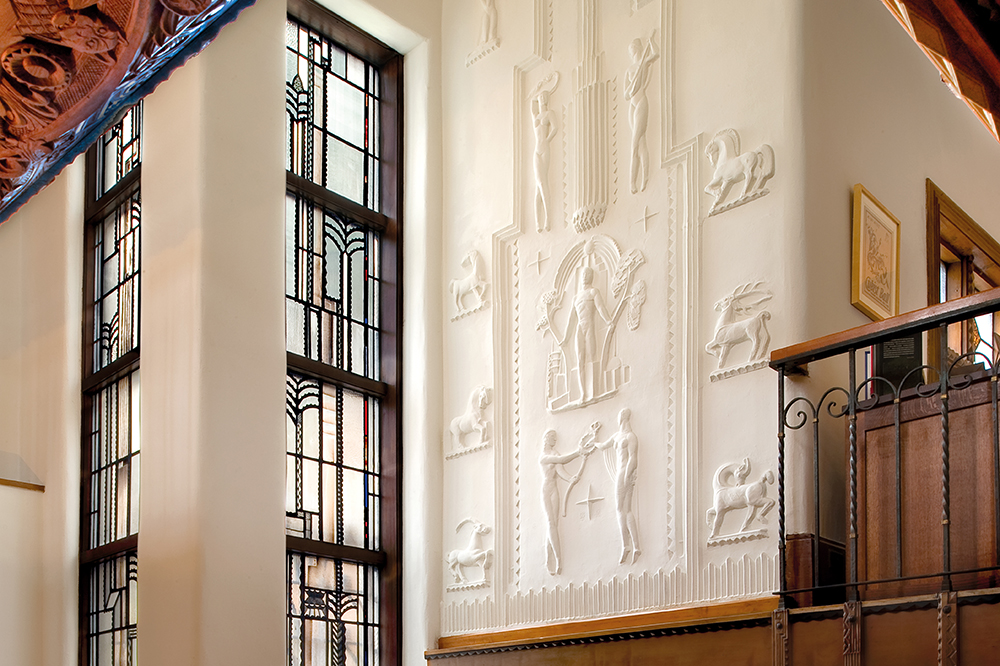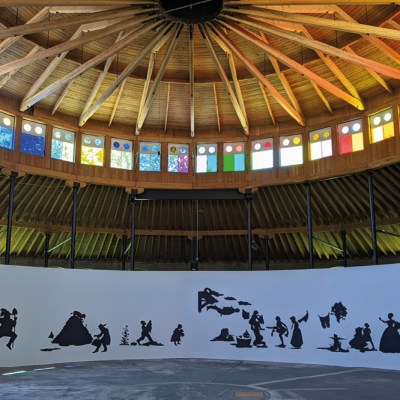From the November 2024 issue of Apollo. Preview and subscribe here.
The red door with its circular window and black iron hinges looks like it must have been imported from China. Or perhaps Anatolia. It must be at least 200 years old, possibly older. The door is meticulously carved with interlocking zigzags and curling sheaves of wheat that evoke Islamic scrolls, while the figure of a horse-bound knight tucked into the border suggests medieval crusades. And is that a cat’s face in the lower right corner, positioned as though peeking through the formal design? That the door is in the middle of an otherwise ordinary strip of town houses in Chicago’s Old Town neighbourhood only adds to the mystique, since it is hard to imagine that it could have originated anywhere nearby. It looks like a valuable artefact made long ago, by artisans now forgotten.
That last assumption, at least, is somewhat accurate. The door was made in the late 1920s and was the handiwork of Chicago-based artist Edgar Miller. Miller, who was born in rural Idaho in 1899, showed artistic promise from an early age. He studied drawing and lithography in Australia, where his family moved briefly while he was a teenager, and enrolled at the School of the Art Institute of Chicago (SAIC) in 1917. In pictures, Edgar Miller looks a bit like Groucho Marx, a handsome rake with a mustache, glasses, a mop of curly hair, and the air of someone who doesn’t take life too seriously.
He was a prolific artist who could work in any medium he chose. Stained glass, carved wood reliefs, ceramics, mosaics – nothing was off limits. In 1936 he was asked to illustrate an atlas of the United States for the Container Corporation of America, a plum gig that later went to graphic-design luminary Herbert Bayer. In the mid ’40s he painted murals for posh hotels and restaurants, such as the Statler Hotel in Washington, D.C., the Hotel Pierre in New York and the Pabst Brewery in Milwaukee. In 1954 he carved scenes of the Great Chicago Fire into huge linoleum panels – freehand, using a razor blade – for Chicago’s upscale Standard Club. Yet few have heard of him. A 2009 monograph about Miller’s work is subtitled ‘Chicago’s Forgotten Renaissance Man’.
Entrance of the Glasner Studio in Chicago. Photo: courtesy Edgar Miller Legacy; © 2008 Alexander Vertikoff/Vertikoff Archive

However, Miller’s low profile is starting to grow, because of the efforts of those dedicated to promoting and preserving his legacy. A compelling survey at the DePaul Art Museum (until 23 February 2025) presents his work in graphic design and decorative arts, and strives to explain why such a widely loved and admired artist fell off the map. The exhibition features wallpaper, advertisements for Marshall Field’s department store and seemingly endless ephemera, including fabric, ashtrays and placemats he designed for restaurants or clubs, as well as drawings, paintings, sculpture and prints.
But Miller’s greatest and most prominent artistic achievement consists of a handful of surviving buildings in Chicago, including the Carl Street Studios, the Kogen-Miller Studios (the location of the red door and the Frank F. Fisher Apartments. Designated the ‘handmade homes’, because each one was painstakingly and uniquely finished by hand, the buildings are a testament to artisanship, ingenuity and resourcefulness. None would exist were it not for artist-entrepeneur Sol Kogen. Kogen and Miller knew each other from their student days at the SAIC, where they both chafed at the school’s conservative views of art. (Kogen let off steam by smashing chairs on the floor during class and fencing during breaks.) Miller saw no boundaries between art and craft, and thought the school made too much of the difference between ‘high’ and ‘low’ art. The pair dropped out of the school, starting an artist group called The Independents, which found a home at Hull House, a settlement house in a poor immigrant neighbourhood on the Near West Side of Chicago.
Hull House was modelled on Toynbee Hall in London, and offered classes in cabinet making, pottery and metalworking, as well as art history. It had kilns, and Miller honed his ceramics technique while he was there. Hull House co-founder Ellen Gates Starr, who was inspired by William Morris and the British Arts and Crafts movement, was also a founder of the Chicago Arts and Crafts Society in 1897. Did Miller cross paths with Starr? There is no record of such an encounter, but Hull House is where Miller fled after dropping out of the SAIC. It is also where he met Jesús Torres, a Mexican immigrant who excelled in ceramics and contributed his considerable artistic gifts to Kogen and Miller’s handmade homes.
Exterior view of Glasner Studio in Chicago. Photo: courtesy Edgar Miller Legacy; © 2008 Alexander Vertikoff/Vertikoff Archive

The genesis of the homes was in 1927, when Kogen bought a rundown 19th-century ‘Victorian’, a house on Chicago’s Near North Side. Kogen, who was the son of Russian immigrants, made a small fortune expanding his parents’ fabric store, and lived in Paris for two years while he tried to make it as an artist. There he was drawn to the artists’ colonies cropping up in the Montmartre district. Kogen turned to Miller for help with the Victorian, asking how he would change the building into studio apartments for artists.
‘The first thing I would do is tear out and connect the first floor and the basement to make a larger room,’ Miller replied. He also suggested putting the staircases outside, allowing the rooms to be bigger. The first nine units of the Carl Street Studios were completed by 1935, and they were an instant hit. Miller worked in exchange for free rent, no small thing during the era of the Great Depression, moving from one studio to the next as he finished the interiors. The apartments that Kogen and Miller created do ‘not work according to the rules taught in that era’, as architecture critic Aaron Betsky has put it, ‘nor those which we still profess in architecture schools’.
The Cathedral Room, decorated by Edgar Miller, in the Glasner Studio (1928–30), Chicago. Photo: courtesy Edgar Miller Legacy Archive; © Alexander Vertikoff

Like his idol, William Morris, Miller was a fierce champion of craft and always sceptical about technology. The artist studios that Miller and Kogen built embody Morris’s vision of the ‘total work of art’. Made by artists, for artists, the apartments include no element that wasn’t considered. Miller never saw a blank surface that wouldn’t benefit from embellishment. Yet he was no Gaudí; Miller exercised restraint, working with muted palettes and enhancing his interiors through ornamentation such as stained glass, painted ceilings, sculpted plaster columns, tiled staircases and, yes, carved doors. Repeating themes, such as triangles or animals, give the rooms coherence. ‘A sound visual culture,’ Miller wrote, ‘should include the entire visual field, every object that can receive consideration,’ and should be ‘permanent enough to deserve the affectionate use of more than one generation.
From the November 2024 issue of Apollo. Preview and subscribe here.



